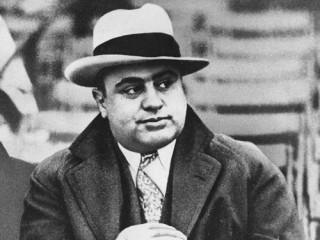
Al Capone biography
Date of birth : 1899-01-17
Date of death : 1947-01-25
Birthplace : Brooklyn, New York, United States
Nationality : American
Category : Famous Figures
Last modified : 2010-08-30
Credited as : American gangster, and criminal, nicknamed "Scarface"
2 votes so far
"Scarface" is born
Alphonso Caponi was born on January 17, 1899, in Brooklyn, New York. He was one of seven children born to Gabriel and Teresa Caponi, who came to the United States from Italy in 1893. His father was a barber. Capone attended school through the sixth grade, at which point he beat up his teacher one day and was himself beaten by the school's principal afterward.
Like many other American children at the time, Capone was taught that the main purpose of life was to acquire wealth and that the United States was the land of opportunity. He discovered that prejudice (unfair treatment) based on his ethnic background made it difficult to succeed in school and that others looked down on the children of immigrants and members of the working class. Angered by the gap between the American dream and his own reality, Capone began to engage in criminal activities as a way of achieving success in what he saw as an unjust society.
Capone worked at odd jobs for a while but found his calling when a gangster named Johnny Torrio (1882–1957) hired him to work in a bar owned by Torrio's friend. Torrio knew Capone did not mind violence and often had him beat up people who were unable to repay loans. Over time, Capone learned more and more about the criminal world. During a fight in a bar he received a razor cut on his cheek, which gained him the nickname "Scarface." He then met a woman named Mae Coughlin (1897–1986), with whom he had a child named Albert Francis Capone (nicknamed Sonny). Capone and Coughlin married a short time later, on December 18, 1918.
Success in Chicago
In 1919 the U.S. government approved the Eighteenth Amendment to the Constitution, a law prohibiting (or preventing) the manufacture, sale, and transport of liquor. The same year, Capone fled Brooklyn for Chicago to avoid a murder charge. In Chicago he joined the Five Points Gang and quickly moved up its ranks. He became the top assistant to the gang's leader, his old friend Johnny Torrio, who had set up operations in the city. Capone worked as a bartender and enforcer for Torrio and was arrested many times for assaulting people, but Torrio's influence saved him from jail.
After Torrio fled the country, Capone found himself in control of part of the bootlegging (illegal supplying of alcohol) in Chicago that had sprung up after Prohibition (preventing by law the production, sale, or transportation of liquor). The citizens of Chicago had not been in favor of Prohibition. Many of them were more than willing to break the law by purchasing alcohol. Capone took advantage of this attitude and conducted his business openly. As he would tell reporter Damon Runyon, "I make money by supplying a public demand. If I break the law, my customers … some of the best people in Chicago, are as guilty as me."
Capone protected his business interests, which also included gambling houses, by waging war on rival gangs. During the St. Valentine's Day massacre in 1929, seven members of a rival gang led by George "Bugsy" Moran were shot to death in a Chicago garage. Protecting these businesses also often involved either bribing or beating up public officials. As Capone's profits continued to grow, he began to act as if he were a well-to-do businessman rather than a vicious criminal. Many people, including members of the police and city government, admired him. Between 1927 and 1931 he was viewed by many as the real ruler of Chicago.
The truth is that Capone was totally unworthy of admiration. He was a cold-blooded criminal who killed hundreds of people without a second thought. He paid off mayors, governors, and other elected officials to allow his crooked operations to continue. He could even influence elections by having members of his gang intimidate people into voting the way he wanted. Capone's reign of terror gave the city of Chicago a reputation as a gangster-infested place that it would hold for years, even after he was long gone.
Menace to society
Most of the rest of the country (and even some people in Chicago) correctly regarded Capone as a menace. In the late 1920s President Herbert Hoover (1874–1964) ordered his secretary of the treasury to find a way to put Capone behind bars. Capone had up to this point managed to escape jail time for any of his crimes. The government's decision to crack down on him just added to the problems he was having. His profits from bootlegging had started to decline as a result of the coming of the Great Depression (a period from 1929 to 1939 during which nearly half the industrial workers in the country lost their jobs) and the ending of Prohibition.
After detailed investigations, U.S. Treasury agents were able to arrest Capone for failure to file an income tax return. Forced to defend himself while being tried on a different charge in Chicago, Capone's testimony regarding his taxes did not match previous statements he had made, and he was found guilty of tax fraud. In October 1931 he was sentenced to ten years of hard labor, which he served in a prison in Atlanta, Georgia, and in prison on Alcatraz Island in California's San Francisco Bay.
Capone suffered from syphilis, a disease passed from person to person through sexual contact. The disease can affect the brain if left untreated. Capone became physically weak and started to lose his mind. As a result, his power within the nation's organized crime system ended. Released on parole in 1939, Capone spent the rest of his life at his estate in Palm Island, Florida, where he died on January 25, 1947.
















